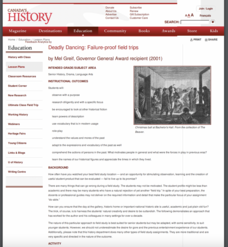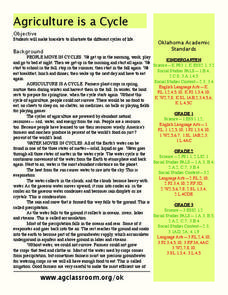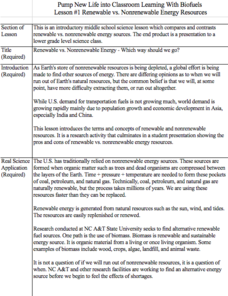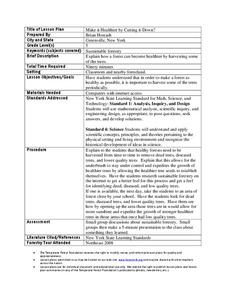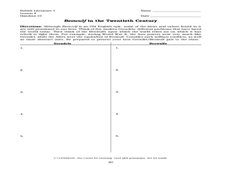Curated OER
Pan de los Muertos (Bread of the Dead)/Mexican Hot Chocolate
Fifth graders examine the role of food in social events. They research a Mexican celebration. They work together to make Mexican hot chocolate.
Curated OER
Deadly Dancing: Failure Proof Field Trips
Students are given an opportunity to role play a particular period of American History. They engage in a field trip that is then reflected upon and further research is done in the class. Their final project is to act out a play they...
Curated OER
Agriculture is a Cycle
Students explore cycles in nature. In this cross curriculum agriculture instructional activity, students define "cycle" and research weather and planting folklore. Students make a bracelet in which individual colored beads represent the...
Curated OER
How to be a Great Navigator!
Students examine historical methods of navigation. They discuss the techniques of "Dead Reckoning," "Heaving the Log," and "Chip Log," pretend to sail from Europe to North America using vectors and determine the location of their...
Curated OER
Mini-Ponds
In this mini pond worksheet, students create a mini-pond ecosystem with soil, water, and plant life. Students let their ecosystem sit for a day and they observe a sample the next day. Students identify all the pond water microorganisms...
Curated OER
Hieroglyphs and Communication
Young scholars compare modern day text messaging with the use of hieroglyphs as forms of communication. They translate hieroglyphic messages written by classmates and check for accuracy.
Illustrative Mathematics
Tilt of Earth's Axis and the Four Seasons
Geometry meets earth science as high schoolers investigate the cause and features of the four seasons. The effects of Earth's axis tilt features prominently, along with both the rotation of the earth about the axis and its orbit...
Kenan Fellows
Renewable vs. Nonrenewable Energy Resources
Is one type of energy inherently good or bad? Young scientists explore energy resources in a week-long unit. After extensive research, groups create powerful position statements and presentations supporting their energy resource of choice.
Scholastic
Opioids and the Overdose Epidemic
Learn about the opioid and overdose epidemic in America with an article that explains what opioids are, how they are used, and how they are abused. Learners discover the death rates associated with opioid overdoses and other factors that...
Healthy Native Youth
Chapter 4: Learning About Disease
Communicable diseases are the focus of a lesson that primarily uses discussion, a hands-on activity, and a worksheet to drive their point home. Lotion and glitter create a strong visual for communicable diseases. A practice page provides...
Curated OER
HIV and AIDS: Understanding Risk Behaviors
Eighth graders research human sexuality by completing a sexual health worksheet. In this HIV lesson, 8th graders define AIDS and list the ways it can be transmitted from human to human. Students assess their own risk and complete study...
Curated OER
World's Deadly Diseases
Young scholars gain knowledge on the cause/effect of five major diseases. They clearly locate where major diseases are located throughout the world. Students obtain statistical information through research of the population of the world...
Curated OER
Living vs. Non-Living Things
Fourth graders describe the characteristics that determine if something is living, dead, or non-living. They determine the difference between living and non-living things. Students determine if an object is living or non-living and...
Curated OER
Make it Healthier by Cutting it Down?
Fifth graders discuss sustainable forestry. In this forestry lesson, 5th graders discuss how healthy forests need to have dead, diseased and lower quality trees cut down and harvested. They visit a local forest and identify these 3 types...
Curated OER
Modern Advocates for Change
Learners make a list of "modern day prophets" and explain how they have made considerable contributions toward the common good. They write a letter to a community leader in which they advocate the solution to a problem or issue in their...
Curated OER
State of Mind: Inventing the American Identity
Students define national identity, explain importance of having national identity, describe America's national identity, work together and formulate class vision of what America's national identity is, identify United States symbols and...
Curated OER
What a Waste
Students analyze components of garbage. They collect and sort a few days' worth of garbage. They chart the results of an investigation.
Curated OER
Radiation: To Worry or Not to Worry
Students distinguish safe forms of radiation from those that are dangerous. Students watch a video about sources of radiation encountered every day. Students estimate their own annual radiation exposure.
Curated OER
Radiation: To Worry or Not to Worry
Middle schoolers distinguish safe forms of radiation from those that are dangerous. Students watch a video about sources of radiation encountered every day. Middle schoolers estimate their own annual radiation exposure.
Curated OER
Dirt Life
Students select and collect soil samples from a variety of locations (schoolyard, home, etc.). They do this lab after an interest-generating discussion about "dirt" and microbes. Students make a dilution in sterile water, plate it on a...
Curated OER
Home of the Brave
Pupils use various types of people and the special places they each call home. They discover houses, like the world, are always changing. Students start out by brainstorming what was the one thing that made a house a home. They were read...
Curated OER
The Concept of the Hero
Students explore the symbolic implications for the concept of the hero with a focus on the Beowulf theme. In this hero concept activity, students find specific examples of monsters from Beowulf to complete the chart. Students list the...
Annenberg Foundation
Teaching Geography: Workshop 4—North Africa/Southwest Asia
Can Jerusalem be equitably organized? Can Israel and Palestine be successfully partitioned? Part one of a two-part workshop looks at the geo-political history of Jerusalem while Part two investigates Egypt's dependence of the Nile River...
Curated OER
Carrying the Torch
Middle schoolers consider how World War II impacted Holocaust survivors. In this Holocaust lesson, students visit selected websites to discover information about the concentration camps, their conditions, and how...
Other popular searches
- Days of the Dead Celebration
- Day of the Dead Celebration
- Day of the Dead Art
- The Day of the Dead Holiday



